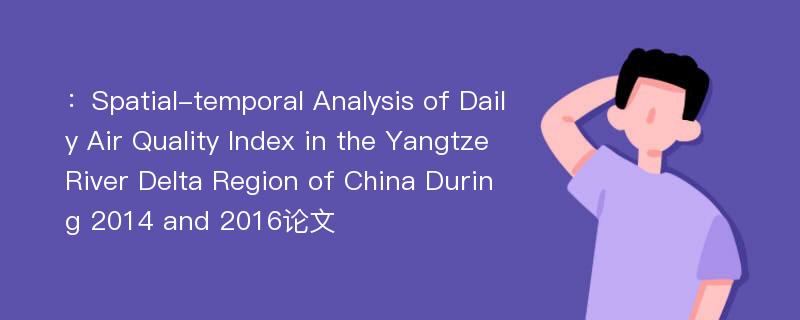
本文主要研究内容
作者(2019)在《Spatial-temporal Analysis of Daily Air Quality Index in the Yangtze River Delta Region of China During 2014 and 2016》一文中研究指出:Urban air pollution is a prominent problem related to the urban development in China, especially in the densely populated urban agglomerations. Therefore, scientific examination of regional variation of air quality and its dominant factors is of great importance to regional environmental management. In contrast to traditional air pollution researches which only concentrate on a single year or a single pollutant, this paper analyses spatiotemporal patterns and determinants of air quality in disparate regions based on the air quality index(AQI) of the Yangtze River Delta region(YRD) of China from 2014 to 2016. Results show that the annual average value of the AQI in the YRD region decreases from 2014 to 2016 and exhibit a basic characteristic of ‘higher in winter, lower in summer and slightly high in spring and autumn’. The attainment rate of the AQI shows an apparently spatial stratified heterogeneity, Hefei metropolitan area and Nanjing metropolitan area keeping the worst air quality. The frequency of air pollution occurring in large regions was gradually decreasing during the study period. Drawing from entropy method analysis, industrialization and urbanization represented by per capita GDP and total energy consumption were the most important factors. Furthermore, population agglomeration is a factor that cannot be ignored especially in some mega-cities. Limited to data collection, more research is needed to gain insight into the spatiotemporal pattern and influence mechanism in the future.
Abstract
Urban air pollution is a prominent problem related to the urban development in China, especially in the densely populated urban agglomerations. Therefore, scientific examination of regional variation of air quality and its dominant factors is of great importance to regional environmental management. In contrast to traditional air pollution researches which only concentrate on a single year or a single pollutant, this paper analyses spatiotemporal patterns and determinants of air quality in disparate regions based on the air quality index(AQI) of the Yangtze River Delta region(YRD) of China from 2014 to 2016. Results show that the annual average value of the AQI in the YRD region decreases from 2014 to 2016 and exhibit a basic characteristic of ‘higher in winter, lower in summer and slightly high in spring and autumn’. The attainment rate of the AQI shows an apparently spatial stratified heterogeneity, Hefei metropolitan area and Nanjing metropolitan area keeping the worst air quality. The frequency of air pollution occurring in large regions was gradually decreasing during the study period. Drawing from entropy method analysis, industrialization and urbanization represented by per capita GDP and total energy consumption were the most important factors. Furthermore, population agglomeration is a factor that cannot be ignored especially in some mega-cities. Limited to data collection, more research is needed to gain insight into the spatiotemporal pattern and influence mechanism in the future.
论文参考文献
论文详细介绍
论文作者分别是来自Chinese Geographical Science的,发表于刊物Chinese Geographical Science2019年03期论文,是一篇关于,Chinese Geographical Science2019年03期论文的文章。本文可供学术参考使用,各位学者可以免费参考阅读下载,文章观点不代表本站观点,资料来自Chinese Geographical Science2019年03期论文网站,若本站收录的文献无意侵犯了您的著作版权,请联系我们删除。
